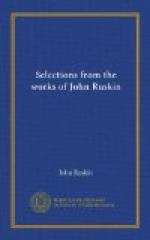We have seen that the main body of the church may be broadly stated to be of the eleventh century, the Gothic additions of the fourteenth, and the restored mosaics of the seventeenth. There is no difficulty in distinguishing at a glance the Gothic portions from the Byzantine; but there is considerable difficulty in ascertaining how long, during the course of the twelfth and thirteenth centuries, additions were made to the Byzantine church, which cannot be easily distinguished from the work of the eleventh century, being purposely executed in the same manner. Two of the most important pieces of evidence on this point are, a mosaic in the south transept, and another over the northern door of the facade; the first representing the interior, the second the exterior, of the ancient church.
It has just been stated that the existing building was consecrated by the Doge Vital Falier. A peculiar solemnity was given to that act of consecration, in the minds of the Venetian people, by what appears to have been one of the best arranged and most successful impostures ever attempted by the clergy of the Romish church. The body of St. Mark had, without doubt, perished in the conflagration of 976; but the revenues of the church depended too much upon the devotion excited by these relics to permit the confession of their loss. The following is the account given by Corner, and believed to this day by the Venetians, of the pretended miracle by which it was concealed.
“After the repairs undertaken by the Doge Orseolo, the place in which the body of the holy Evangelist rested had been altogether forgotten; so that the Doge Vital Falier was entirely ignorant of the place of the venerable deposit. This was no light affliction, not only to the pious Doge, but to all the citizens and people; so that at last, moved by confidence in the Divine mercy, they determined to implore, with prayer and fasting, the manifestation of so great a treasure, which did not now depend upon any human effort. A general fast being therefore proclaimed, and a solemn procession appointed for the 25th day of June, while the people assembled in the church interceded with God in fervent prayers for the desired boon, they beheld, with as much amazement as joy, a slight shaking in the marbles of a pillar (near the place where the altar of the Cross is now), which, presently falling to the earth, exposed to the view of the rejoicing people the chest of bronze in which the body of the Evangelist was laid.”




